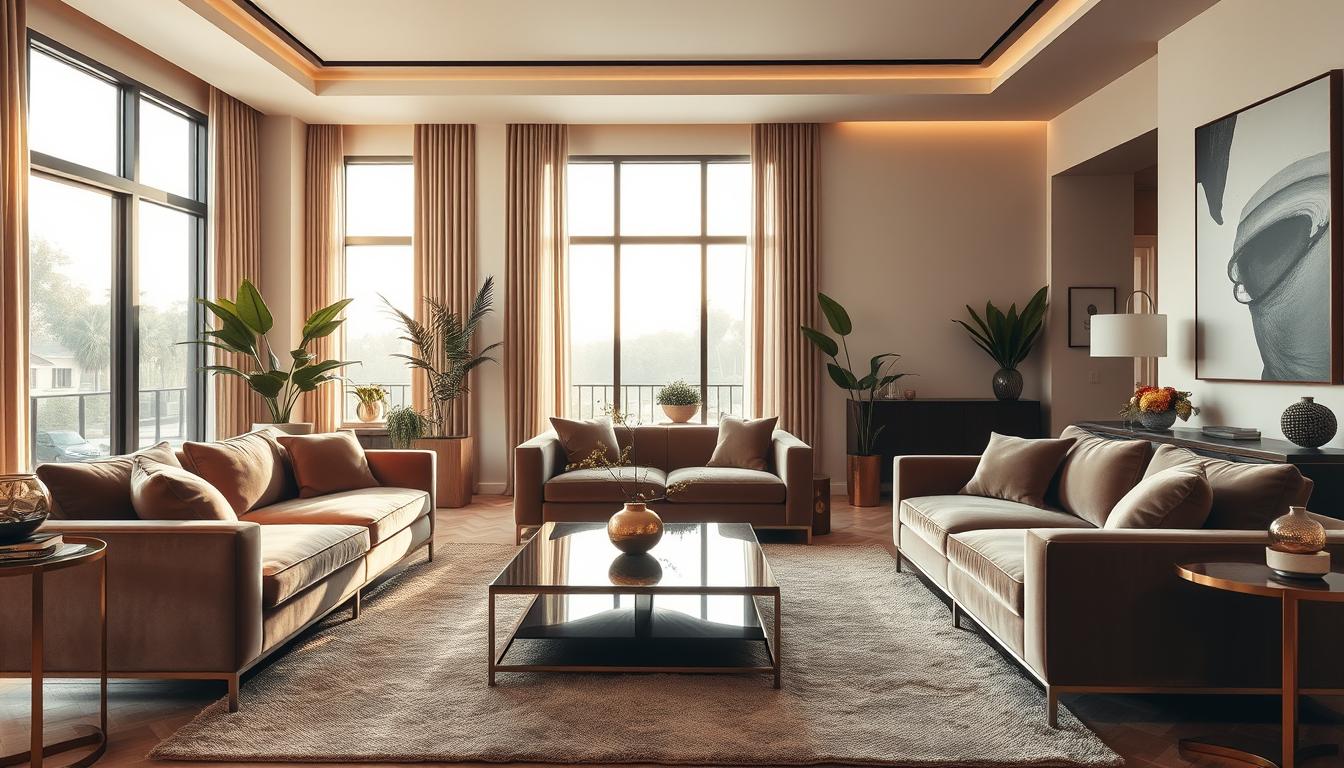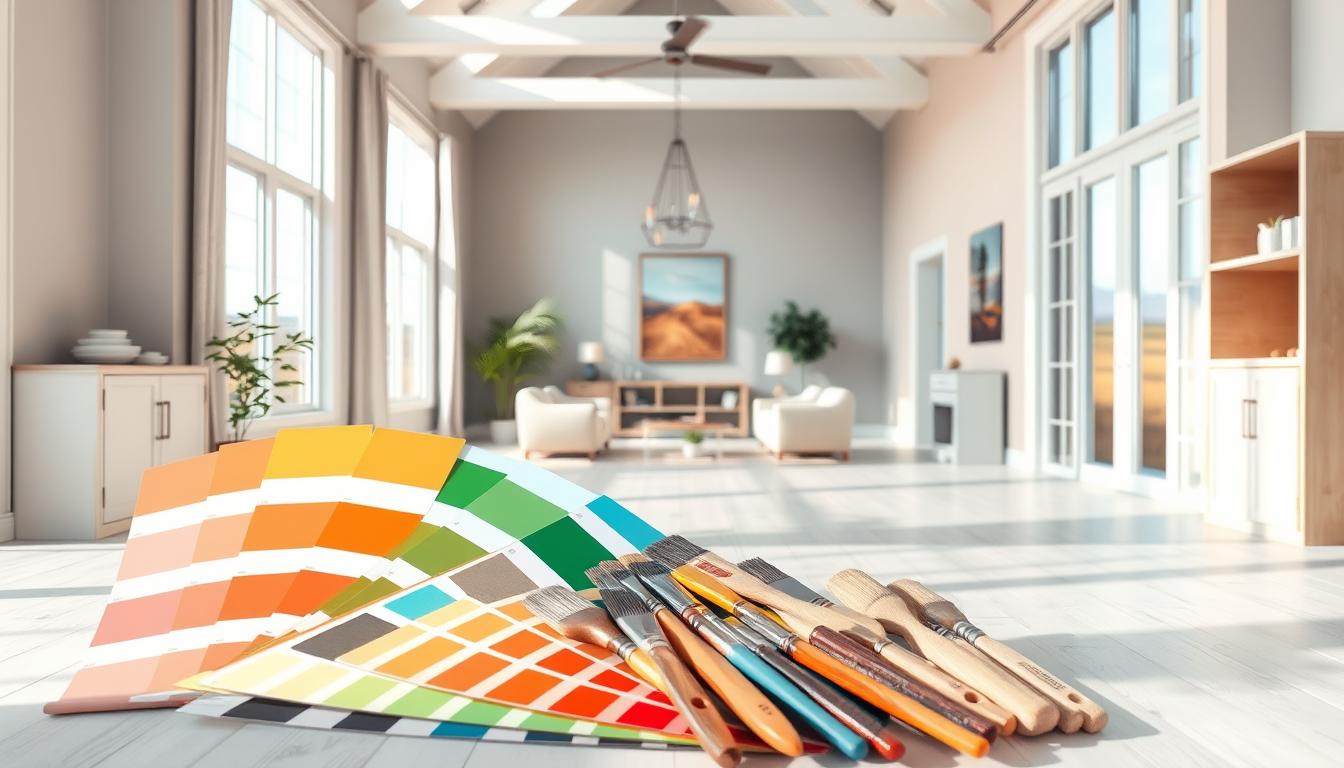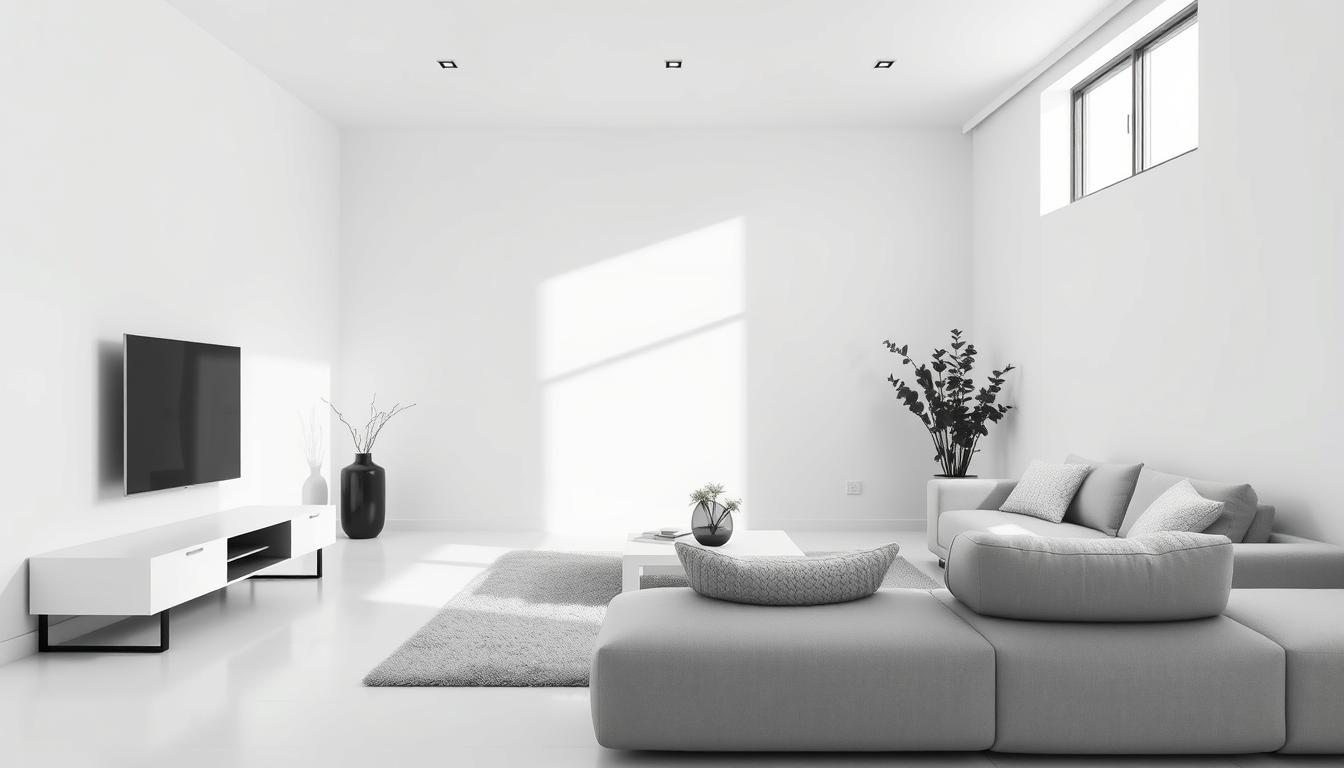Many of us want our homes to be both stylish and functional. We spend about $1,000 each year on interior design ideas. This shows we’re serious about making our homes beautiful and cozy.
Exploring home design interior is key. We need to know what makes a space truly special. We’ll share the best tips for a stylish and useful home.
Key Takeaways
- Understand the basics of home design interior
- Incorporate textures and patterns to add depth
- Invest in quality furniture for a stylish space
- Don’t be afraid to experiment with different styles
- Balance functionality with aesthetics
Understanding the Basics of Home Design Interior
To make a space stylish and useful, knowing the basics of home design interior is key. It includes furniture, lighting, color, and texture. These elements work together to make a space welcoming and balanced.
What is Home Design Interior?
Home design interior is about making a living space beautiful and useful. It involves knowing different design styles, from old to new. Traditional design is inspired by old European styles, offering elegance. Modern design is about a specific time, while contemporary design keeps up with today’s trends.
For those looking for home renovation inspiration, knowing design styles is important. It helps in choosing the right elements for the renovation.
Key Principles of Interior Design
The key principles of interior design help create a beautiful and useful space. These include:
- Balance: This is about the visual weight in a room, using color, texture, and furniture.
- Proportion: It’s about the size of elements in a room, making sure they fit well together.
- Harmony: This is about creating a pleasing atmosphere with colors, textures, and styles that match.
By using these principles, homeowners can make a space that looks good and works well. It shows their personal style and taste.
Importance of Space Planning
Space planning is vital in home design interior. It’s about arranging space for different areas and making sure they flow well. Good space planning can make a room feel bigger or cozier, depending on what you want.
In modern home decor, space planning is even more crucial. It often means creating open spaces that are both useful and stylish.
Choosing the Right Color Palette
A well-chosen color palette is key to luxury home interiors. It sets the mood for your living area. The colors you pick greatly affect the feel and use of your space.
Color Psychology in Home Design
Color psychology is vital in contemporary interior design. Colors can stir up different feelings and moods. Warm colors like rust and terracotta make a space feel cozy and welcoming, like the American desert.
Cool colors, such as blues and greens, help you relax and feel calm. It’s important to know how colors affect us when picking a palette for your home. It’s not just about picking colors you like. It’s about creating a mood that makes each space better.
Tips for Selecting Complementary Colors
Choosing complementary colors can be tricky, but there are tips to help. First, remember the 60-30-10 rule: 60% of a main color, 30% of a secondary color, and 10% of an accent color. This mix brings harmony and interest.
- Begin with a neutral base, like whites or beiges, common in coastal designs.
- Add a secondary color that goes well with the neutral base.
- Use accent colors to add personality and flair to your space.
Using Color to Define Spaces
Color is a strong tool for dividing spaces in your home. By using different colors, you can make each area feel separate and functional. For instance, a unique color for a home office can make it stand out from the rest of the living area.
Selecting Furniture for Optimal Comfort
Choosing the right furniture is key to a cozy living space. The right pieces can make a room look great and feel comfortable for everyday use.
Factors to Consider When Choosing Furniture
Several things matter when picking furniture. Comfort is top, as it shapes how you feel at home. Durability is also vital, so your furniture lasts long. And style sets the mood of your home.
Think about these when deciding:
- The material and build of the furniture
- How the furniture fits with the room and other items
- What each piece does and how it serves you
Balancing Style and Functionality
Finding a balance between looks and use is crucial. Minimalist design helps by focusing on simplicity and what’s needed.
| Design Element | Style Contribution | Functional Benefit |
|---|---|---|
| Clean Lines | Boosts the room’s look | Makes it easier to clean |
| Multi-functional Pieces | Keeps the space tidy | Does more than one thing, adding value |
| Neutral Color Palette | Brings calm and unity | Makes decorating simple |
Trends in Sustainable Furniture
The push for sustainable furniture is growing. It’s good for the planet and adds a special touch to your home.
Some trends include:
- Using eco-friendly materials
- Items made from recycled or upcycled stuff
- Furniture made to last, cutting down on replacements
By going for creative home styling and choosing sustainable, comfy, and stylish furniture, you can make a space that’s both lovely and practical.
Maximizing Space in Smaller Homes
You can make a small living space stylish and useful with the right strategies. It’s all about interior design trends that are both beautiful and practical.
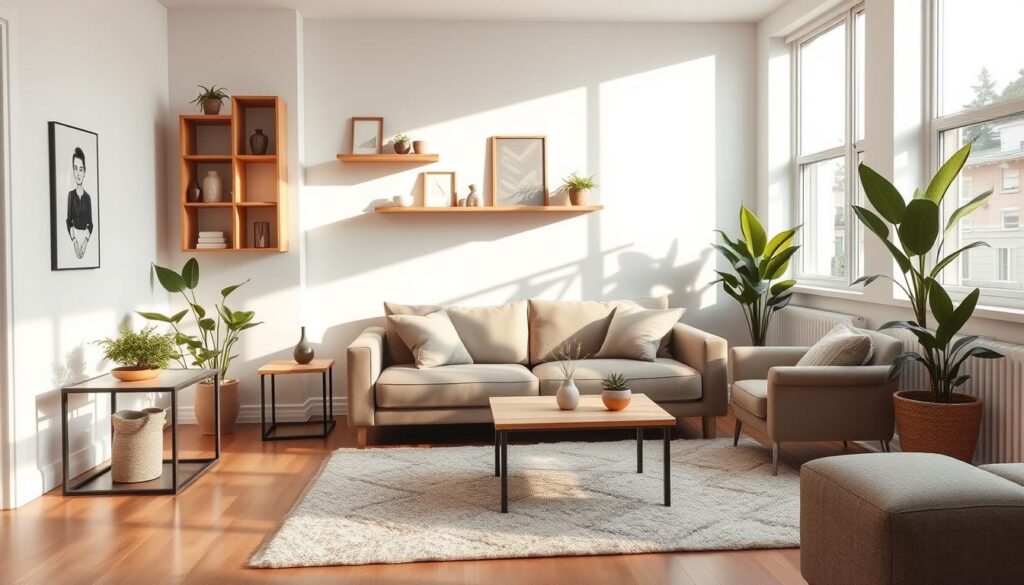
Creative Storage Solutions
Finding enough storage in small homes can be tough. Creative storage solutions are key. Think about hidden spots like under-bed storage or secret cabinets to keep things tidy and hidden.
Using vertical space is also smart. Tall shelves or storage systems that reach the ceiling offer lots of room. They also make the room feel taller and more open.
Multi-Functional Furniture Options
In small homes, multi-functional furniture is essential. Items like sofa beds, storage ottomans, and coffee tables with storage do double duty. They save space by reducing the need for extra furniture.
| Furniture Piece | Primary Function | Secondary Function |
|---|---|---|
| Sofa Bed | Seating | Sleeping |
| Storage Ottoman | Footrest | Storage |
| Coffee Table with Storage | Surface for Drinks/Snacks | Storage for Magazines/Remotes |
Open-Concept Living Spaces
Open-concept living is a big trend in small homes. It means removing walls to make the space feel bigger. This design makes the home feel more open and functional, allowing for better movement and interaction.
To make an open-concept space work, use area rugs and different lighting. This helps define zones without losing the open feel. It’s a clever way to organize your space.
Lighting: Transforming Your Home’s Atmosphere
Lighting is key in modern home decor. It changes a room’s feel and look. It’s not just about light; it also makes spaces look better and work better.
Different Types of Lighting
Knowing the types of lighting is important. There are ambient, task, and accent lights. Ambient lights light up the whole room. Task lights focus on areas for work. Accent lights highlight special features or objects.
Using all three types together creates a rich, interesting lighting effect. It adds depth and beauty to your rooms.
The Role of Natural Light
Natural light makes a space feel open and welcoming. It cuts down on the need for artificial light during the day. It also boosts mood and energy.
Using big windows, skylights, or mirrors can bring in more natural light. This makes your home feel better and more inviting.
Tips for Layering Interior Lighting
Layering lighting means mixing different lights for a cozy feel. Start with ambient lighting. Then add task lighting where needed. Finish with accent lighting to highlight special things.
Using dimmers lets you change light levels. This makes your space more flexible and inviting, no matter the time or activity.
| Lighting Type | Purpose | Examples |
|---|---|---|
| Ambient | Overall illumination | Ceiling fixtures, floor lamps |
| Task | Focused lighting for tasks | Desk lamps, under-cabinet lighting |
| Accent | Highlighting features or objects | Track lighting, picture lights |
By using different lights and natural light, you can change your home’s feel. It becomes more welcoming and useful.
Incorporating Textures and Patterns
To make your home decor more interesting, learn how to mix textures and patterns well. This not only makes your space look better but also feels cozier and more welcoming.
Understanding Texture in Decor
Texture is very important in home design. It can change how you feel in a room. For example, using wood and stone can make your home feel warmer and more luxurious.
When picking textures, think about the style you want for your home. For a simple look, balance different textures carefully. Mix smooth and rough textures to create a nice contrast.
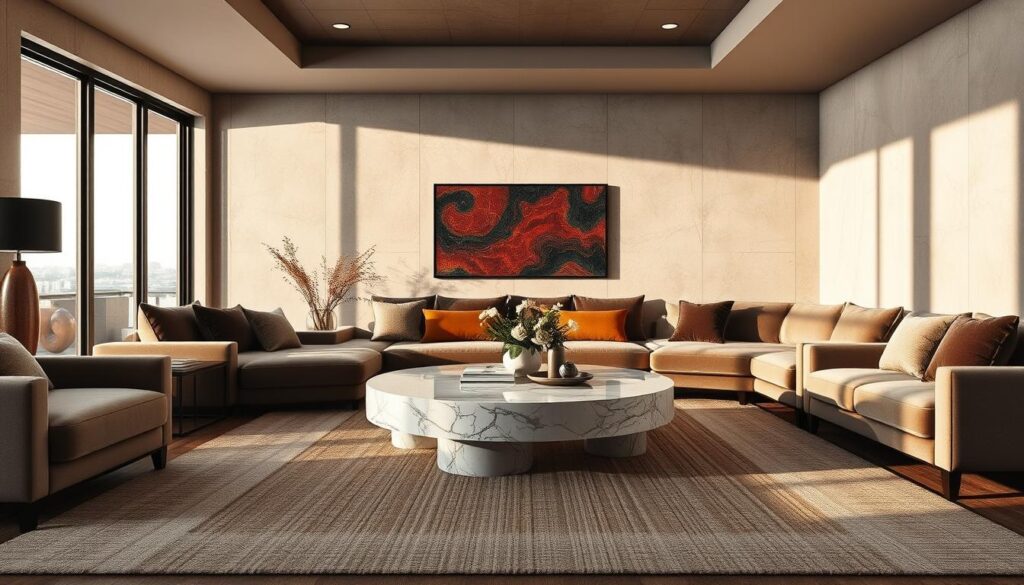
Mixing Patterns for Visual Interest
Mixing patterns can make your home look stylish and unique. But, it’s important to do it in a balanced way. Start with a main pattern and add smaller ones to it. This keeps the space from feeling too busy.
- Choose patterns that share a common color palette to create cohesion.
- Vary the scale of patterns to add visual interest.
- Balance bold patterns with neutral backgrounds.
Seasonal Texture Trends
Seasonal texture trends can update your home decor. For cold months, use thick textures like velvet and wool for warmth. In warm seasons, lighter textures like linen and cotton make your home feel bright and airy.
By keeping up with these trends, you can keep your home looking stylish all year. Whether you prefer luxury or simplicity, the right textures and patterns can make a big difference.
Personalizing Your Home’s Interior
Making your house a home is more than just furniture. It’s about creating a space that tells your story. Personalizing your home’s interior is key to making it truly yours. By adding elements that reflect your personality, interests, and experiences, you can turn a house into a home.
Adding Meaningful Decor
Adding meaningful decor is a great way to personalize your home. This can include family heirlooms, personal mementos, or items collected during travels. Such items add character to your space and spark interesting conversations.
- Display personal items such as photos, awards, or collectibles.
- Incorporate items that reflect your hobbies or interests.
- Use decor that holds sentimental value.
Showcasing Personal Collections
Showcasing personal collections is another way to add a personal touch. Whether it’s vintage items, artwork, or rare books, your collections can make your decor unique. Display them in a way that looks good and is easy to access.
Here are some tips for showcasing collections:
- Group similar items together for a cohesive display.
- Use the right lighting to highlight your collections.
- Rotate your collections to keep the display fresh.
Importance of Artwork in Spaces
Artwork is crucial in home design, adding elegance and sophistication. Choosing artwork that speaks to you personally can make your space feel more intimate and reflective of your style.
When picking artwork, think about:
- The color palette and how it matches your decor.
- The style and theme of the artwork and how it fits with your home’s aesthetic.
- The emotional response the artwork evokes and how it makes you feel.
By thoughtfully adding meaningful decor, showcasing personal collections, and choosing impactful artwork, you can create a home that is not only beautiful but also deeply personal.
The Role of Accessories in Interior Design
Accessories can turn a house into a home, adding personality and style. They play a big role in interior design. They can make a room look elegant and sophisticated.
Choosing Appropriate Accessories
Choosing the right accessories is key. They can change how a space feels and works. Think about the look you want and what you need. For example, a vase can decorate, while a storage ottoman can offer both seating and storage.
When picking accessories, think about their style, material, and size. A modern room might need sleek, metallic items. A traditional room might look better with ornate, wooden pieces.
Tips for Choosing Accessories:
- Think about the room’s purpose and your style.
- Choose items that match the decor.
- Don’t overdo it; keep it balanced.
Balancing Accessories with Minimalism
Accessories can enhance a space, but balance is crucial. Too many can make a room feel cluttered and chaotic. A minimalist approach can help, focusing on a few key pieces that add interest without overwhelming the space.
“The key to a well-designed space is not just about filling it with things, but about creating a sense of harmony and balance.”
To find this balance, use the 60-30-10 rule. This means 60% of the room should be a main color, 30% a secondary color, and 10% an accent color. This rule helps guide your choices, ensuring they enhance the space without cluttering it.
| Accessory Type | Minimalist Approach | Maximalist Approach |
|---|---|---|
| Vases | Single, statement piece | Multiple, varied sizes and styles |
| Throw Pillows | Limited to one or two per room | Multiple, in various patterns and textures |
Seasonal Accessories for Freshness
Seasonal accessories can keep your home looking fresh and updated. Simple changes like swapping throw pillows or adding seasonal flowers can make a big difference.
Seasonal accessories also help create a sense of tradition in your home. For example, displaying Christmas decorations each year can become a special family tradition.
Ideas for Seasonal Accessories:
- Winter: Use rich, warm colors and textures like wool and velvet.
- Spring: Incorporate pastel colors, floral patterns, and natural elements like branches and flowers.
- Summer: Brighten up with light, airy fabrics and coastal-inspired decor.
- Autumn: Warm up with earthy tones, pumpkins, and fall leaves.
Outdoor to Indoor Transitions
Making a smooth transition between outdoor and indoor spaces is key in modern interior design ideas. It boosts your home’s look and makes it feel bigger and more welcoming.
To blend these areas well, use similar materials, colors, and textures. For example, if your deck is made of wood, match that wood tone in your indoor flooring or furniture.
Creating a Cohesive Look
Choosing a theme or style that ties both spaces together is crucial. Pick a color palette or material that you use everywhere. This creates a unified look.
| Element | Outdoor Application | Indoor Application |
|---|---|---|
| Wood | Decking | Flooring, Furniture |
| Stone | Paving, Patios | Feature Walls, Fireplaces |
| Plants | Gardens, Pots | Indoor Pots, Green Walls |
Using Plants to Connect Spaces
Plants are great for linking your outdoor and indoor spaces. Pick plants that do well in both places. Use plants with similar textures and colors to your garden.
Opening Up with Large Windows
Big windows are perfect for merging indoors and outdoors. They let in lots of natural light and offer a clear view of your outdoor area. This makes your indoor space feel like an extension of your garden.
By using these contemporary interior design tips, you can make a living space that feels open and connected. It seamlessly blends your outdoor and indoor areas.
Planning Your Layout for Functionality
To make your home both beautiful and useful, planning your layout is key. A well-planned layout boosts your home’s look and makes it more functional.
Common Layout Mistakes to Avoid
When planning, avoid mistakes that can make your space feel tight or uncomfortable. Common errors include poor flow, not enough storage, and ignoring your home’s natural path.
For example, placing furniture that blocks the room’s path can make it feel small. Also, lacking storage can lead to clutter, which harms your home’s feel.
Zoning Different Areas Effectively
It’s important to zone your home’s areas well. This creates clear spaces for different activities, like cooking, dining, or relaxing.
In an open-concept area, arrange furniture to make zones for lounging and dining. This boosts the space’s function and adds visual appeal.
Using Rugs to Define Spaces
Rugs are great for marking off different areas in a big space. By picking rugs with unique colors, textures, or patterns, you can visually separate spaces.
In a big living room, a rug can make the seating area cozy and welcoming. In an open-plan office, rugs can mark off different work areas.
| Layout Element | Purpose | Tips |
|---|---|---|
| Rugs | Define spaces | Choose rugs with different colors or patterns to create visual boundaries. |
| Furniture Arrangement | Create zones | Arrange furniture to define different areas for different activities. |
| Lighting | Enhance ambiance | Use layered lighting to create a warm and inviting atmosphere. |
Maintaining Your Home’s Design
To keep your home looking its best, regular maintenance is key. We can keep our living spaces beautiful and functional by following a few simple steps. These steps should be part of our daily routine.
Keeping Your Space Fresh
Regular updates are important to keep your home looking fresh. Try adding interior design trends to give it a modern look. A minimalist design can also help keep your space clean and clutter-free.
Seasonal Care
Seasonal maintenance is also crucial. It helps prevent damage and wear and tear. By doing seasonal tasks, we can keep our homes beautiful and functional all year.
Deep Cleaning for Longevity
Deep cleaning is essential for keeping your home in top shape. Regular deep cleaning helps maintain the quality of your living space. It keeps your home looking its best for many years.

